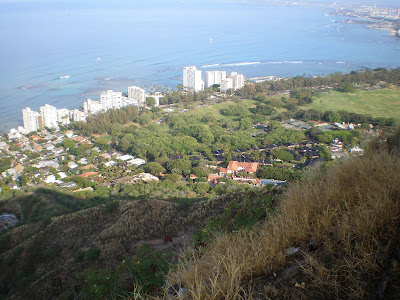




The second place that we visited was the Manoa Heritage Center. It is a non-profit organisation established since 1996 which aims to promote thoughtful stewardship of the natural and cultural heritage of Hawaii. The historic site consist of Kuku'o'o' Heiau (an ancient spiritual site), a native Hawaiian garden, and the historic home of the Kuali'i. The center is committed to preserving and interpreting the garden, the historic home, and the natural and cultural history of Manoa Valley for future generation. The historic house was built in 1911 by Charles Montague Cooke Jr. using the stone quarried on the site. It has been listed on the National Register of Historic Places but is still a private home and not open for tours. The Heiau at the back of the house is the only one that are left and the Cooke has taken the initiative to restore it physically and culturally to its use in the year 1993. Historical evidence suggest that the Heiau eventually became an agricultural temple for the mapele class dedicated ti the rites and rituals surrounding food productivity. Surrounding the Heiau is a Native Hawaiian Garden featuring the endemic and indigenous plants as well as Polynesian introductions. The Polynesian introductions are the plants that were brought by the Polynesians on their voyage to find a new land which include the coconut, taro, ricegrass and others. This is because they are unsure whether the new land will have foods so they bring along with them the seeds which can cultivate foods. However, when they found and settled in Hawaii, they also have found good uses for the native plants especially for medicine purposes.





The final destination for the day is the Hanauma Bay. Hanauma Bay Nature Preserve, one of the most spectacular natural resources in Hawaii, is enjoying the benefits of over a decade of moves to reestablished its prestined marine ecosystem. Recognising the damage done by years of neglect and abuse by allowing around 3 millions visitors anually, the City and County of Honolulu in 1990 laid out a plan to restore Hanauma Bay to a clean, healthy state by reducing the number of visitors, establishing an education program, and instituting supportive restriction (http://www.honolulu.gov/parks/facility/hanaumabay/welcome.htm). We were given a briefing by the park's volunteer on the background and how they do things. Before entering the park, the visitors must watch a video clip on the things not to do on the bay which include not to feed the fish because the fish will become more aggressive and not very healthy as well as attracting too many fish to come than what the bay can handle. They also limited the number of people on the bay by providing only a certain amount of parking lots and each vehicles can only have a maximum of 3 people. They also limited to only 300 stalls to prevent more people to come. Other than that, the tour agent must get a permit to bring in tourist and they only have limited number of tourist that they can bring. Those without the permit are only allowed to bring in the tourists for 15 minutes to take pictures and enjoy the scenery and then leave. The park also uses several chickens to control the bug population including cocroaches at the bay. They had also changed the use of septic tank to centralised sewerage treatment plant to prevent leakages into the water. In addition, the park keep a close eyes on the food chain at the bay to ensure that the marine ecology is sustained.




































